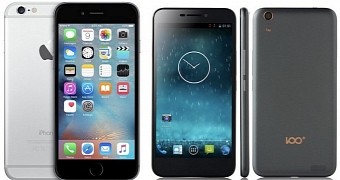In 2016, Chinese officials ruled that Apple could no longer sell its iPhone 6 and iPhone 6 Plus phones in the country, because they violated a manufacturer’s patent. Shenzhen Baili filed a lawsuit in June last year, claiming that Apple allegedly violated the patent of its 100c smartphone.
After the lawsuit was filed, the Beijing Intellectual Property Office ruled that Apple’s iPhone 6 and 6 Plus did in fact infringe on patent rights, claiming that Apple allegedly copied the exterior design of the 100c phone.
Chinese authorities ordered Apple to halt sales in Beijing, but the decision was overturned by an appeal and the phones remained on shelves. Recently, a Chinese Court ruled in favor of Apple and decided that the Cupertino company didn’t infringe the design of the patent filed by Shenzhen Baili company, according to Reuters.
The Court said that Apple’s iPhone 6/6 Plus and Shenzhen Baili’s 100c were easily distinguishable for consumers. The decision surely pleases Apple, especially since the company recently released a red variant of its iPhone 7 and iPhone 7 Plus models in China too.
Apple wants the design patent to be removed
The tech giant had requested the Patent Reexamination Board of State Intellectual Property Office to remove the design patent awarded for Shenzhen Baili’s 100c model, but the company was turned down. Apple is considering a second appeal of this decision.
Shenzhen Baili has been struggling lately, as the company is no longer a competitor in the Chinese market and has lost its market share because of mismanagement and customers displeased with poor quality phones.
Truth be told, iPhone 6 and iPhone 6 Plus barely resemble the design of Shenzhen Baili’s 100c smartphone. Only the sensor shape on the back of the phones is similar with a rounded design, while the position of the LED flash is completely different.
In addition, Apple’s two devices have antenna lines on the back, which aren’t featured on the 100c. The difference is even more striking on the front panel, the 100c doesn’t have a physical home button and the position of the front sensor isn’t the same on both phones.

 14 DAY TRIAL //
14 DAY TRIAL //